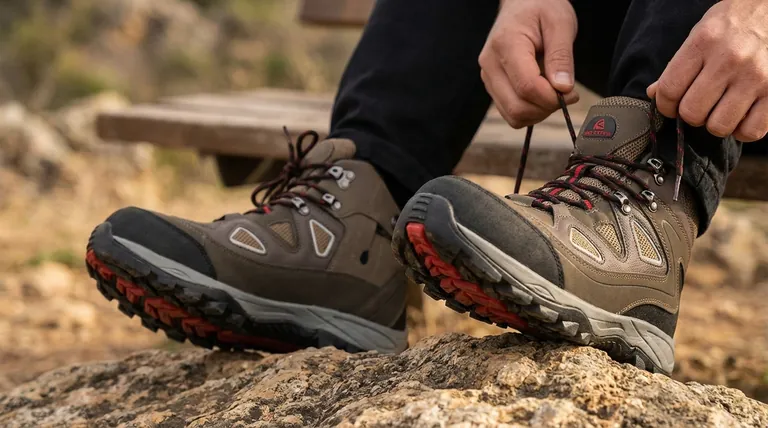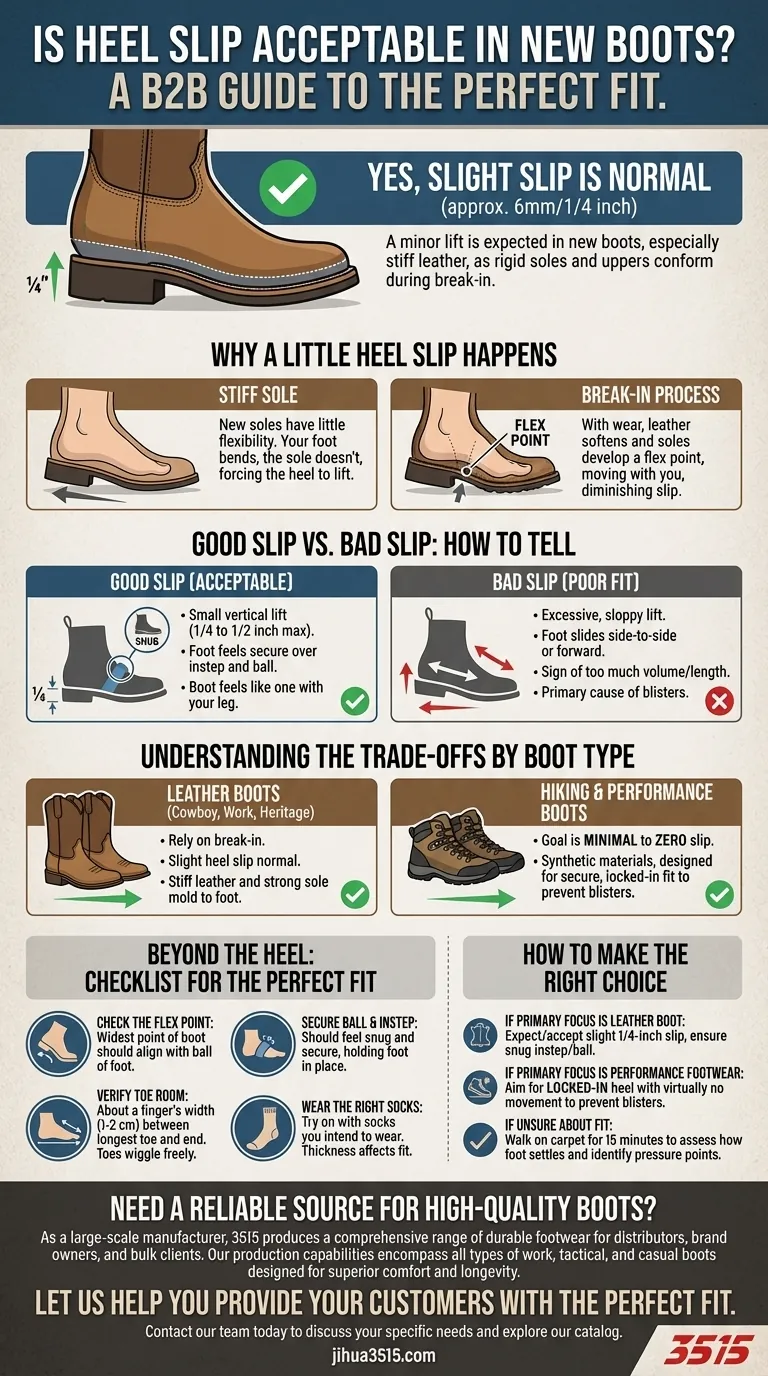Yes, a slight heel slip is not only acceptable but often expected when trying on new boots, especially those made from stiff leather. A minor lift of about a quarter-inch (around 6mm) is a normal part of the break-in process as the rigid sole and upper materials begin to conform to the natural movement of your foot.
The critical distinction is not whether your heel slips, but how much and why. Your goal is to differentiate between the slight, temporary lift of a boot breaking in and the excessive, sloppy movement of a boot that simply does not fit.

Why a Little Heel Slip Happens
When boots are new, their components are at their most rigid. This initial stiffness is the primary reason your heel may lift slightly as you walk.
The Role of a Stiff Sole
A brand-new sole, particularly on a well-made leather or hiking boot, has very little flexibility. When you step, your foot bends, but the sole doesn't bend with it yet. This forces your heel to lift away from the insole.
The Break-In Process
As you wear the boots, the leather will soften and the sole will develop a "flex point" that aligns with the natural bend of your foot. As the boot begins to move with you instead of against you, this initial heel slip should diminish significantly.
Good Slip vs. Bad Slip: How to Tell the Difference
Knowing what to look for is key to avoiding a purchase you'll regret. The character of the slip is more important than its mere presence.
Signs of "Good" (Acceptable) Slip
A good slip is typically a small, vertical lift of about a quarter-inch to a maximum of a half-inch. Your foot should still feel secure elsewhere, particularly over the instep and at the ball of your foot. The boot feels like it's one with your leg, even if the heel lifts slightly.
Red Flags of a "Bad" (Poor Fit) Slip
Bad slip is excessive and sloppy. If your heel is lifting more than half an inch, or if your foot is sliding side-to-side or forward inside the boot, it's a sign the boot is too large in volume or length. This will not improve with time and is a primary cause of blisters.
Understanding the Trade-offs by Boot Type
The amount of acceptable heel slip varies significantly depending on the boot's intended purpose and construction.
Leather Boots (Cowboy, Work, Heritage)
These boots rely on a break-in period. A slight heel slip is perfectly normal and expected. The stiff leather and strong sole need time and wear to mold to your foot for a custom-like fit.
Hiking & Performance Boots
For these boots, the goal is minimal to zero heel slip. They are often made of synthetic materials and designed to provide a secure, locked-in fit from the start to prevent friction and blisters during high-exertion activities. Any noticeable slip is a major concern.
Beyond the Heel: A Checklist for the Perfect Fit
Heel slip is just one piece of the puzzle. To assess the overall fit, you must evaluate the entire boot.
1. Check the Flex Point
The boot's widest point should align with the ball of your foot, allowing the boot to bend exactly where your foot bends. If it bends too far forward or back, the proportions are wrong for your foot.
2. Secure the Ball and Instep
The boot should feel snug and secure around the ball of your foot and over your instep. This is what "holds" your foot in place and prevents it from sliding forward, even if the heel is lifting slightly.
3. Verify Toe Room
You should have about a finger's width (or 1-2 centimeters) of space between your longest toe and the end of the boot. Your toes should be able to wiggle freely without being cramped.
4. Wear the Right Socks
Always try on boots with the same type of socks you intend to wear with them. A thick hiking sock can dramatically alter the fit compared to a thin dress sock.
How to Make the Right Choice
When you're in the store or trying boots on at home, use these guidelines to make a confident decision.
- If your primary focus is a leather boot (work, cowboy, or casual): Expect and accept a slight 1/4-inch heel slip, but ensure the boot is snug and secure across your instep and the ball of your foot.
- If your primary focus is performance footwear (especially for hiking): Aim for a locked-in heel with virtually no movement from the very first step; this is critical for preventing blisters on the trail.
- If you are at all unsure about the fit: Walk around on a carpeted surface for at least 15 minutes to see how your foot settles and to identify any potential pressure points before committing.
Ultimately, understanding the signs of a proper fit empowers you to invest in comfort and quality that will last for years.
Summary Table:
| Type of Boot | Acceptable Heel Slip? | Key Consideration |
|---|---|---|
| Leather Boots (Work, Cowboy) | Yes, up to 1/2 inch | Snug instep and ball of foot are critical; slip should diminish with break-in. |
| Hiking & Performance Boots | No, aim for zero slip | A locked-in heel from the start is essential to prevent blisters. |
| General Rule | Up to 1/4 inch is often normal | Character of slip (vertical vs. sloppy) is more important than its mere presence. |
Need a Reliable Source for High-Quality Boots?
As a large-scale manufacturer, 3515 produces a comprehensive range of durable footwear for distributors, brand owners, and bulk clients. Our production capabilities encompass all types of work, tactical, and casual boots designed for superior comfort and longevity.
Let us help you provide your customers with the perfect fit.
Contact our team today to discuss your specific needs and explore our catalog.
Visual Guide

Related Products
- Safety Footwear Wholesale Manufacturer for Custom OEM/ODM Production
- Wholesale Safety Footwear Manufacturer for Bulk & Custom OEM Orders
- Premium Flame-Retardant Waterproof Safety Boots and Shoes
- Durable Goodyear Welt Leather Work Boots for Wholesale & Private Label
- Puncture-Resistant Velcro Safety Boots for Wholesale & Custom Manufacturing
People Also Ask
- What are the differences between steel toe, composite toe, and alloy toe Wellington boots? Choose the Right Safety Toe for Your Job
- How do safety shoes contribute to cost savings for companies? A Strategic Investment in Risk and Cost Management
- What are the cultural perspectives on wearing shoes in the house? A Guide to Home Etiquette & Hygiene
- What cultural and environmental considerations are tied to wearing shoes indoors? Balance Hygiene, Tradition, and Foot Health
- Is it normal to wear shoes in the house? A Guide to Hygiene, Comfort & Culture



















